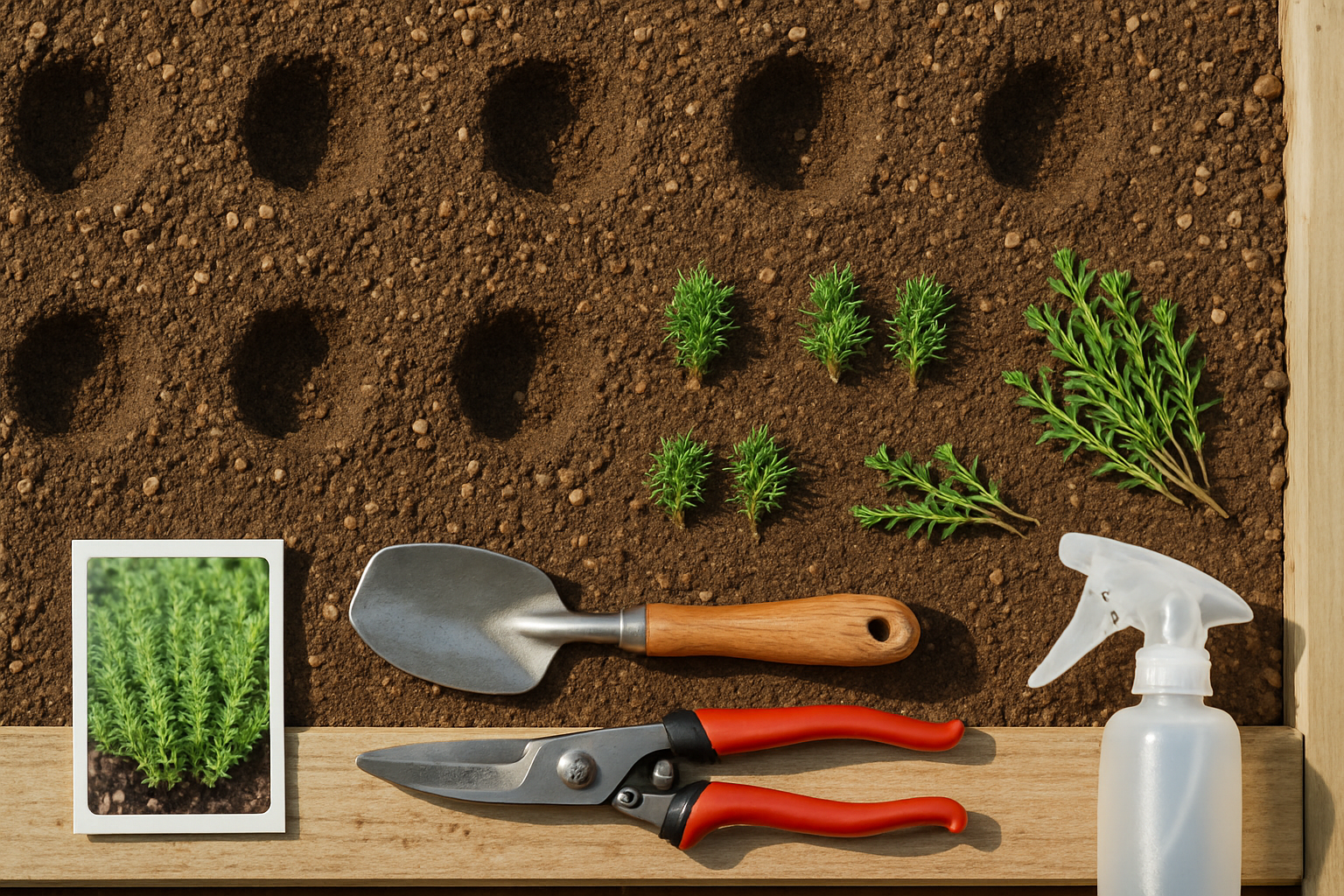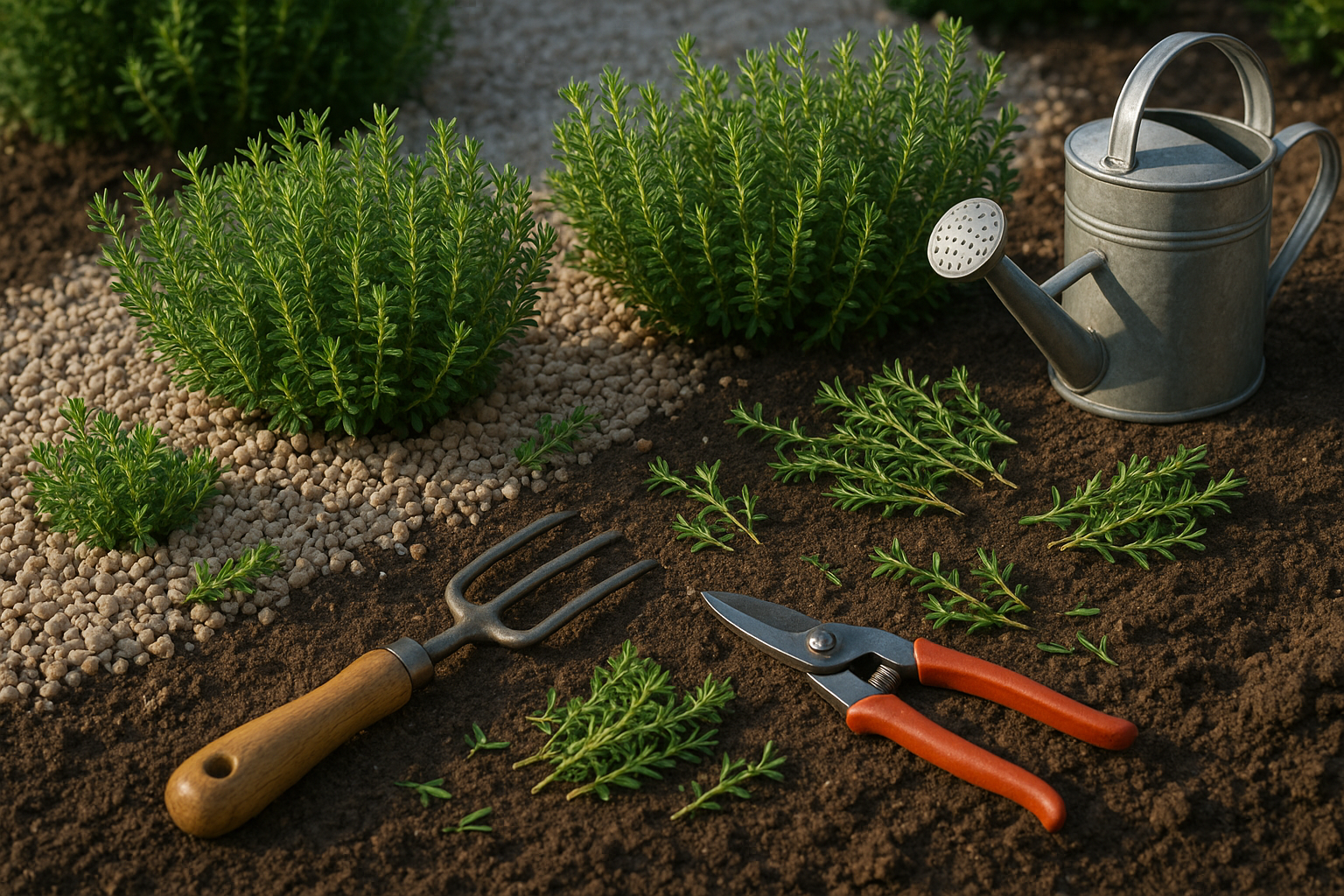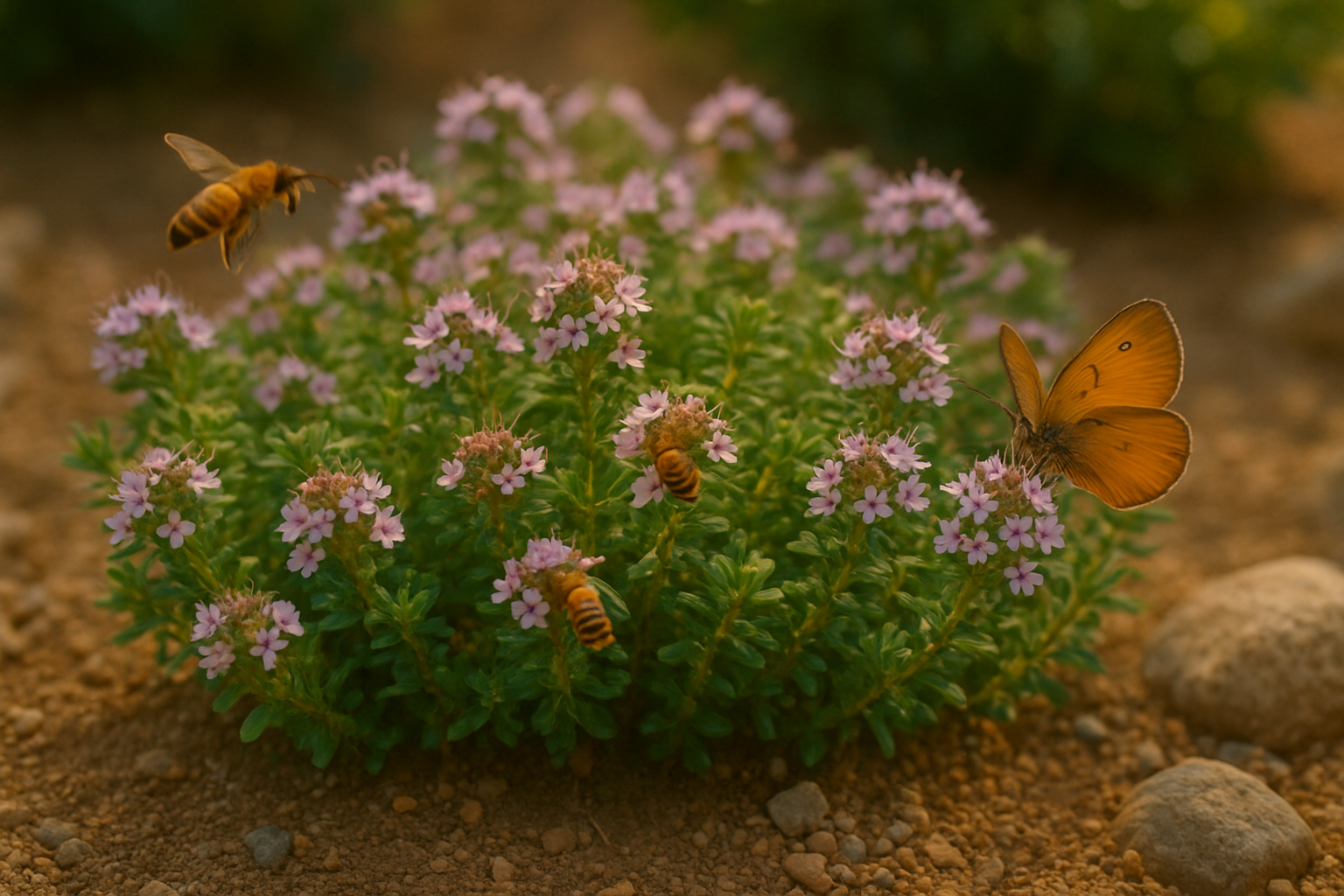Why Grow Thyme Outdoors?
Growing thyme outdoors comes with a ton of benefits, making it perfect for both beginner and experienced gardeners. Not only does thyme add amazing flavor to dishes—from roasted veggies to savory meats—but its aromatic leaves also attract pollinators like bees and butterflies, helping support a healthy garden ecosystem.
This little herb is super useful as a low-maintenance ground cover, too. Its dense foliage crowds out weeds, keeping your flower beds looking tidy. Thyme thrives outdoors because it’s naturally hardy; it’s drought-tolerant and grows well in various climates, often staying green year-round as a perennial in many areas.
Thanks to its resilience, you won’t have to worry about constant watering, and it bounces back quickly after dry spells. It fits nicely into garden beds, rock gardens, or along borders, creating a lush green carpet accented by tiny, fragrant blooms in late spring and early summer.
Whether you’re edging a walkway, filling spaces between stepping stones, or boosting a vegetable plot, thyme adapts well and looks great doing it. Here’s a practical tip: plant thyme near other sun-loving herbs or veggies to naturally help deter pests.
With its culinary, ecological, and decorative roles, thyme is a smart and attractive addition to any outdoor space.
Selecting the Right Thyme Variety
When choosing the right thyme variety for your garden, start by considering how you plan to use the plant and your local climate. Common thyme (Thymus vulgaris) is the classic choice for most culinary uses, prized for its robust, earthy flavor that holds up well in soups, roasts, and stews. It thrives in full sun and well-drained soil, making it a reliable option for gardeners in a range of temperate climates.
Lemon thyme (Thymus × citriodorus) offers a bright, citrusy aroma that works beautifully in salads, fish dishes, and herbal teas—plus, it brings ornamental value with its slightly golden-tinged foliage. Lemon thyme tolerates similar growing conditions to common thyme but may appreciate a bit of afternoon shade in very hot regions.
For ground cover or rock gardens, creeping thyme (Thymus serpyllum) is a standout. This low-growing variety forms a dense mat of foliage and tiny flowers, perfect for filling gaps between stepping stones, attracting pollinators, or creating a fragrant, walkable carpet. While not as intensely flavored as culinary thymes, some creeping varieties are still edible in small amounts and are especially valued for their resilience and ornamental charm.
When selecting a thyme variety, always check zone hardiness; common and creeping thyme generally handle colder climates better than lemon thyme. Whether buying starter plants or seeds, look for reputable nurseries or seed companies. Healthy thyme plants will have vibrant, green leaves with no wilting or brown spots and should show no signs of rotting at the base. If starting from seed, check the packet for germination rates and planting recommendations.
Finally, ask local gardeners or cooperative extension offices about varieties that perform well in your area—sometimes, a local recommendation is the best tip for flavor and success.
Preparing for Planting
Healthy thyme starts with the right soil, as this aromatic herb hates “wet feet.” Good drainage is essential—avoid heavy clay, which can hold water and cause root rot. If your garden’s soil doesn’t drain well, try mixing in plenty of sand or small gravel to improve texture, or consider growing thyme in raised beds and pots.
Thyme thrives in poor to average soils with a slightly alkaline pH of about 6.0 to 8.0. You can test your pH with an inexpensive kit from a garden center; if the soil is too acidic, sprinkle a little garden lime to adjust. Unlike needy vegetables, thyme doesn’t require rich soil, so resist adding lots of fertilizer; a scoop of compost at planting time is plenty.
Sunlight is another essential—thyme loves full sun and needs at least six hours of direct light per day to develop its signature flavor and compact growth. In shadier spots, thyme can get leggy and prone to disease, so choose the brightest spot you have, whether that’s in the garden or on a sunny balcony.
Timing your planting is key for success. In most regions, wait until after your last spring frost for outdoor planting—thymus seedlings are sensitive to cold snaps. In mild climates, you can plant almost any time the soil is workable, while in cooler or more unpredictable regions, late spring to early summer is ideal. If you’re in the southern US, fall planting works well since thyme enjoys cooler, less humid conditions. Whichever region you’re in, aim to plant when the soil is warm to the touch and nighttime temperatures stay above 50°F (10°C).
This attention to soil, sun, and timing will set your thyme up for healthy, hassle-free growth all season long.
How to Plant Thyme Outdoors

Planting thyme outdoors is simple and rewarding, whether you start from seeds, seedlings, or cuttings. To plant seeds, choose a sunny spot with well-draining soil—thyme loves warmth and hates wet roots. Scatter the seeds lightly over the soil surface and barely press them in, as thyme seeds need light to germinate and shouldn’t be buried deep.
Water gently using a spray bottle to keep the soil just moist until tiny seedlings appear, usually in 2–3 weeks. When the seedlings reach a couple of inches tall, thin them so each plant is spaced about 12 to 18 inches apart, giving them plenty of room to spread.
If you’re using seedlings from a nursery or cuttings from a mature plant, dig a hole just large enough for the roots or stem. For cuttings, strip the lower leaves and plant the stem about 2 inches deep, then firm the soil gently around it. Water newly planted thyme thoroughly, but let the soil dry out a bit between waterings—a soggy environment can cause root rot.
Propagating Thyme
To expand your herb garden, take a 4-inch cutting from a healthy thyme plant, dip the cut end in rooting hormone (optional), and plant it directly in moist soil or a pot. You can also gently divide mature thyme clumps in early spring and replant the divided sections elsewhere in your garden.
Mulch around the plants to retain moisture and suppress weeds, but keep mulch away from the stems. With these techniques, your thyme patch will thrive and multiply, ready to flavor your favorite dishes!
Essential Care and Maintenance

Caring for thyme is straightforward, but a few mindful routines can greatly boost your plant’s health. The key is to water thyme only when the soil feels completely dry; overwatering is a common mistake, as thyme thrives in well-drained, almost arid conditions.
During droughts or hot summer spells, check the soil more frequently, but always avoid soggy roots. Mulching with light materials like gravel helps retain just enough moisture and prevents competing weeds without holding too much water near the stems.
Fertilizing is best done sparingly—too much can lead to floppy, less flavorful leaves. Feed your thyme once at the start of the growing season with a balanced, slow-release fertilizer or a little compost, then skip additional feeding for the rest of the year.
Keeping the area weed-free is essential; thyme can be quickly crowded out by aggressive weeds, so pull them regularly, especially during the plant’s first year as it establishes.
To encourage robust, bushy growth and extend your thyme’s life, prune it after flowering by trimming a third of the stems, always cutting just above a pair of leaves. Regular light harvesting, never removing more than a third of the plant at a time, also keeps it compact and full. Removing old, woody stems each spring encourages new growth.
Maintaining this rhythm of thoughtful care—responsive watering, gentle fertilizing, consistent mulching, vigilant weeding, and timely pruning—will reward you with healthy, aromatic thyme ready to flavor your cooking for many seasons.
Harvesting and Using Your Thyme
Harvest thyme in the morning after the dew has dried but before the sun gets too strong—this is when the oils are most concentrated, giving the best fragrance and flavor. To harvest without harming your plant, use sharp scissors or garden shears to snip stems just above a leaf node, leaving at least two-thirds of the plant intact so it can continue growing vigorously.
Fresh thyme is incredibly versatile in the kitchen:
- Sprinkle whole sprigs on roasted vegetables or meats.
- Infuse oils for added flavor.
- Strip the leaves and add them to soups, marinades, and salad dressings.
For a natural, soothing homemade cleaner, steep fresh thyme in vinegar to deodorize and disinfect surfaces.
If you prefer dried thyme for longer storage, bundle a few stems together and hang them upside down in a warm, dark, and well-ventilated area. Alternatively, use a dehydrator for faster results. Once the leaves are crispy, crush them and store in an airtight container away from light.
Freezing is another easy option—scatter whole sprigs or chopped leaves in a freezer bag, or pack them into ice cube trays with a bit of water, then pop out a flavorful cube whenever you need it.
Whether you’re adding fragrant freshness to your dishes or using thyme around the house, with a little planning and care, you can enjoy your abundant harvest year-round.
Common Problems and Solutions
Growing healthy thyme at home comes with its share of challenges, but most issues can be managed with some simple know-how. One common problem is poor growth, often caused by overwatering or heavy, poorly-draining soil. Thyme prefers dry, slightly sandy conditions, so make sure to plant it in well-drained soil and avoid watering until the top inch is dry.
Root rot can be a risk if conditions are too wet—look for yellowing leaves and a mushy base as warning signs.
Pests like aphids, spider mites, and thrips may attack your thyme, especially if plants are overcrowded. Combat them by spraying with a gentle insecticidal soap or introducing beneficial insects like ladybugs.
Fungal diseases such as powdery mildew and gray mold sometimes crop up, particularly in humid climates or where air circulation is poor. Keep plants spaced apart, prune regularly, and water at the base to limit humidity on the foliage. Mulching with a light layer of gravel can also help keep leaves dry and deter fungal spores.
To keep your thyme vibrant, rotate the planting location every few years, especially if the bed shows signs of disease or stunted growth. Avoid replanting thyme or other mint-family herbs in the same spot for at least three years to disrupt the life cycles of soil-borne pests and pathogens.
If a thyme plant seems beyond rescue—showing persistent wilting, severe leaf drop, or spreading rot—it’s best to remove it and amend the soil before replanting. Regularly harvesting sprigs and promptly removing diseased or damaged foliage also keeps your thyme bed strong.
By staying attentive and practicing good garden hygiene, you’ll ensure your thyme patch remains lush and productive year after year.
